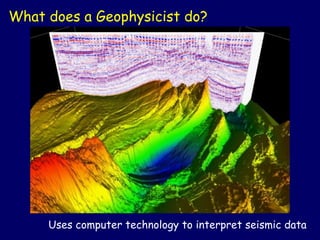All Categories
Featured
Table of Contents
Marine Geophysicist - Explore The Seafloor in Kallaroo WA 2023

(PREM)., and the borders in between layers of the mantle are consistent with phase transitions.

This makes plate tectonics possible. Schematic of Earth's magnetosphere. The solar wind Circulations from left to. If a planet's magnetic field is strong enough, its interaction with the solar wind forms a magnetosphere. Early space probes mapped out the gross dimensions of the Earth's magnetic field, which extends about 10 Earth radii towards the Sun.
Inside the magnetosphere, there are relatively thick regions of solar wind particles called the Van Allen radiation belts. Geophysical measurements are usually at a particular time and place. Accurate measurements of position, together with earth contortion and gravity, are the province of geodesy. While geodesy and geophysics are separate fields, the two are so closely linked that many scientific organizations such as the American Geophysical Union, the Canadian Geophysical Union and the International Union of Geodesy and Geophysics incorporate both.
Introducing Geophysical Surveying in Caversham Western Australia 2021
, combines huge coordinates and the local gravity vector to get geodetic coordinates. This method just supplies the position in 2 collaborates and is more challenging to use than GPS.
Gravity measurements ended up being part of geodesy due to the fact that they were needed to associated measurements at the surface of the Earth to the reference coordinate system.
Water level can also be determined by satellites using radar altimetry, adding to a more precise geoid. In 2002, NASA introduced the Gravity Recovery and Climate Experiment (GRACE), wherein two twin satellites map variations in Earth's gravity field by making measurements of the distance between the two satellites utilizing GPS and a microwave ranging system. , which are studied through geophysics and area physics.
Hydrographic And Geophysical Surveys in Gosnells Australia 2020

Considering that geophysics is worried with the shape of the Earth, and by extension the mapping of functions around and in the world, geophysical measurements consist of high accuracy GPS measurements. When the geophysical measurements have been processed and inverted, the interpreted outcomes are plotted utilizing GIS.
Many geophysics companies have designed internal geophysics programs that pre-date Arc, GIS and Geo, Soft in order to satisfy the visualization requirements of a geophysical dataset. Exploration geophysics is used geophysics that typically utilizes remote noticing platforms such as; satellites, airplane, ships, boats, rovers, drones, borehole sensing equipment, and seismic receivers.
For instance, aeromagnetic data (airplane gathered magnetic data) gathered utilizing conventional fixed-wing aircraft platforms should be fixed for electromagnetic eddy currents that are produced as the airplane moves through Earth's electromagnetic field. There are likewise corrections connected to modifications in measured possible field strength as the Earth turns, as the Earth orbits the Sun, and as the moon orbits the Earth.
Definition: Geophysical Survey in Morley Australia 2021
Signal processing includes the correction of time-series data for unwanted noise or mistakes introduced by the measurement platform, such as airplane vibrations in gravity information. It likewise involves the decrease of sources of sound, such as diurnal corrections in magnetic information. In seismic information, electromagnetic information, and gravity data, processing continues after mistake corrections to consist of computational geophysics which lead to the final interpretation of the geophysical data into a geological analysis of the geophysical measurements Geophysics became a separate discipline just in the 19th century, from the intersection of physical geography, geology, astronomy, meteorology, and physics.
The magnetic compass existed in China back as far as the 4th century BC. It was used as much for feng shui as for navigation on land. It was not until good steel needles might be forged that compasses were utilized for navigation at sea; prior to that, they could not keep their magnetism enough time to be useful.
By taking a look at which of eight toads had the ball, one could determine the instructions of the earthquake. It was 1571 years before the very first style for a seismoscope was published in Europe, by Jean de la Hautefeuille. It was never ever developed. Among the publications that marked the start of contemporary science was William Gilbert's (1600 ), a report of a series of precise experiments in magnetism.
Geoscience, Geophysics Option, in West Swan WA 2020
Dietmar; Sdrolias, Maria; Gaina, Carmen; Roest, Walter R. (April 2008). "Age, spreading rates, and spreading asymmetry of the world's ocean crust". Geochemistry, Geophysics, Geosystems. 9 (4 ): Q04006. Bibcode:2008 GGG ... 9. 4006M. doi:10. 1029/2007GC001743. S2CID 15960331. "Earth's Inconstant Magnetic Field". science@nasa. National Aeronautics and Space Administration. 29 December 2003. Obtained 13 November 2018.
Runcorn, S.K, (editor-in-chief), 1967, International dictionary of geophysics:. Pergamon, Oxford, 2 volumes, 1,728 pp., 730 fig Geophysics, 1970, Encyclopaedia Britannica, Vol. Intro to seismology (2nd ed.).
Latest Posts
Geophysical Survey in Jandakot Australia 2020
Geophysics Definition & Meaning in Roleystone Oz 2021
Geophysical Survey - Explore The Seafloor in Kinross WA 2021